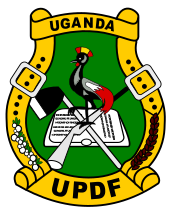Ugandan Air Force
| Uganda People's Defence Force |
|
|---|---|

Uganda People's Defence Force emblem
|
|
| Service branches | Land Forces, Air Force, Special Operations Command |
| Headquarters | Kampala, Uganda |
| Leadership | |
| President | Yoweri Museveni |
| Minister of Defense and Veteran Affairs | Adolf Mwesige |
| Chief of defence forces | General David Muhoozi (since January 2017) |
| Manpower | |
| Military age | 18 years of age |
| Active personnel | 46,800 (2014) |
| Expenditures | |
| Budget | UGX: 933.6 billion (2015) |
| Percent of GDP | 1.2% (2015) |
| Industry | |
| Foreign suppliers | Russia China Poland United States Italy |
| Related articles | |
| History | Military history of Uganda |
The Uganda People's Defence Force (UPDF), previously known as the National Resistance Army, is the armed forces of Uganda. From 2007 to 2011, the International Institute for Strategic Studies estimated the UPDF had a total strength of 40,000–45,000 and consisted of land forces and an air wing.
After Uganda achieved independence in October 1962, British officers retained most high-level military commands. Ugandans in the rank and file claimed this policy blocked promotions and kept their salaries disproportionately low. These complaints eventually destabilized the armed forces, already weakened by ethnic divisions. Each post-independence regime expanded the size of the army, usually by recruiting from among people of one region or ethnic group, and each government employed military force to subdue political unrest.
The origins of the present Ugandan armed forces can be traced back to 1902, when the Uganda Battalion of the King's African Rifles was formed. Ugandan soldiers fought as part of the King's African Rifles during the First World War and Second World War. As Uganda moved toward independence, the army stepped up recruitment, and the government increased the use of the army to quell domestic unrest. The army was becoming more closely involved in politics, setting a pattern that continued after independence. In January 1960, for example, troops were deployed to Bugisu and Bukedi districts in the east to quell political violence. In the process, the soldiers killed twelve people, injured several hundred, and arrested more than 1,000. A series of similar clashes occurred between troops and demonstrators, and in March 1962 the government recognized the army's growing domestic importance by transferring control of the military to the Ministry of Home Affairs.
On 9 October 1962, Uganda became independent from the United Kingdom, with 4th Battalion, King's African Rifles, based at Jinja, becoming the Uganda Rifles. The traditional leader of the Baganda, Edward Mutesa, became president of Uganda.Milton Obote, a northerner and longtime opponent of autonomy for the southern kingdoms including Buganda, was prime minister. Mutesa recognized the seriousness of the rank-and-file demands for Africanising the officer corps, but he was more concerned about potential northern domination of the military, a concern that reflected the power struggle between Mutesa and Obote. Mutesa used his political power to protect the interests of his Baganda constituency, and he refused to support demands for Africanization of the officer ranks.
...
Wikipedia
